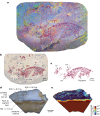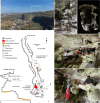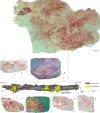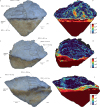Narrative cave art in Indonesia by 51,200 years ago
- PMID: 38961284
- PMCID: PMC11269172
- DOI: 10.1038/s41586-024-07541-7
Narrative cave art in Indonesia by 51,200 years ago
Abstract
Previous dating research indicated that the Indonesian island of Sulawesi is host to some of the oldest known rock art1-3. That work was based on solution uranium-series (U-series) analysis of calcite deposits overlying rock art in the limestone caves of Maros-Pangkep, South Sulawesi1-3. Here we use a novel application of this approach-laser-ablation U-series imaging-to re-date some of the earliest cave art in this karst area and to determine the age of stylistically similar motifs at other Maros-Pangkep sites. This method provides enhanced spatial accuracy, resulting in older minimum ages for previously dated art. We show that a hunting scene from Leang Bulu' Sipong 4, which was originally dated using the previous approach to a minimum of 43,900 thousand years ago (ka)3, has a minimum age of 50.2 ± 2.2 ka, and so is at least 4,040 years older than thought. Using the imaging approach, we also assign a minimum age of 53.5 ± 2.3 ka to a newly described cave art scene at Leang Karampuang. Painted at least 51,200 years ago, this narrative composition, which depicts human-like figures interacting with a pig, is now the earliest known surviving example of representational art, and visual storytelling, in the world3. Our findings show that figurative portrayals of anthropomorphic figures and animals have a deeper origin in the history of modern human (Homo sapiens) image-making than recognized to date, as does their representation in composed scenes.
© 2024. The Author(s).
Conflict of interest statement
The authors declare no competing interests.
Figures








References
-
- Aubert, M. et al. Pleistocene cave art from Sulawesi, Indonesia. Nature514, 223–227 (2014). - PubMed
-
- Aubert, M. et al. Earliest hunting scene in prehistoric art. Nature576, 442–444 (2019). - PubMed
-
- Aubert, M., Brumm, A. & Taçon, P. S. C. The timing and nature of human colonization of Southeast Asia in the Late Pleistocene—a rock art perspective. Curr. Anthropol.58, S553–S566 (2017).
-
- Aubert, M. A review of rock art dating in the Kimberley, Western Australia. J. Archaeol. Sci.39, 573–577 (2012).
Publication types
LinkOut - more resources
Full Text Sources

